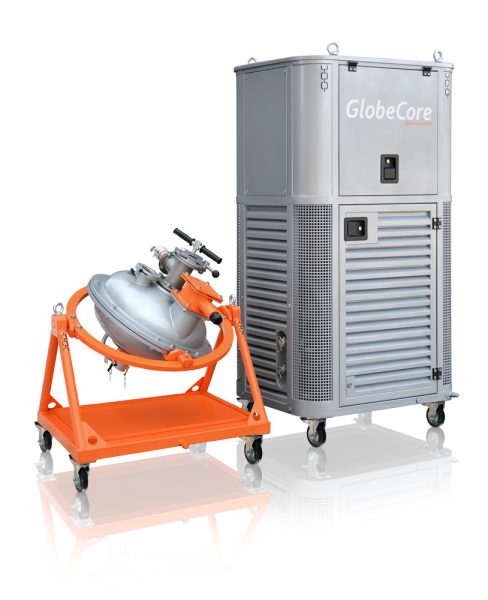Cavitation is one such recent technique which has been found to be substantially beneficial in wastewater treatment.
Cavitation can be described as formation, growth and sub-sequent collapse of cavities releasing large magnitudes of energy locally, creating conditions similar to hot spots, and also generating strong oxidizing conditions by way of production of hydroxyl radicals and also hydrogen peroxide.
 The efficacy of cavitational reactors can be significantly enhanced by combining cavitation with other oxidation processes or by using catalysts and/or additives.
The efficacy of cavitational reactors can be significantly enhanced by combining cavitation with other oxidation processes or by using catalysts and/or additives.
Cavitational reactors can be recommended as pre-treatment methods of waste purification.
By combining conventional and cavitational technologies we can achieve complete purification of industrial wastewaters which contain heavy metal ions, chromium compounds, phenol and also organic and inorganic substances.
Engineers from PC GlobeCore have used the cavitational principle to design AVS unit or Magnetic Vortex Activator. In cavitating water purification devices the extreme conditions of cavitation can break down pollutants and organic molecules.
The main way of AVS unit application is wastewater treatment. Usage of this unit leads to acceleration of industrial wastewater neutralization, reducing energy and reagents consumption.
Consider the following example “wastewater treatment from phenol and other organic contaminants”.
“Cavitation can be described as formation, growth and sub-sequent collapse of cavities releasing large magnitudes of energy locally, creating conditions similar to hot spots, and also generating strong oxidizing conditions by way of production of hydroxyl radicals and also hydrogen peroxide”.
We have designed new uninterrupted way of wastewater treatment from phenol and other organic contaminants by means of vortex layer (cavitational process). We tested artificial wastewater by Intensifier of Technological Process AVS. These wastewaters contain similar concentration of phenol, acid and contaminants as real manufacturer’s wastewaters.
Research suggests that Intensifier of Technological Process provides qualitative treatment of wastewater from phenol at lower costs to compare with other known methods.
Conditions of the wastewater treatment by AVS unit from phenol concentration 0.5-10 g/dm3 and acidity of the medium 5 g/dm3 are as follows:
- oxidizing agents: potassium bichromate (concentration 0.2-5 g/dm3); manganese dioxide (concentration 1.2-10 g/dm3); potassium permanganate (concentration 0.1-1.0 g/dm3);
- wastewater’s temperature – 20–45 °С;
- oxidization time – 0.1-2 seconds.
AVS unit industrial process flowsheet is much simpler in technological execution than contemporary industrial process flowsheets.
According to this process flowsheet phenol wastewater enters to equalizing reservoir which is made to blending and equalization of phenol concentration. Wastewater and potassium bichromate (oxidizing agent with concentration 150–300 g/dm3) inject to the unit working chamber by means of pump.
Phenol oxidizes in apparatus from where wastewater injects to another vortex layer machine. In the second stage hexavalent chromium regenerates by ferrous sulfate in alkaline medium and at the same time neutralizes and settle Cr3+. As alkaline agent can be used lime, soda or other reagents.
 While wastewater treating from phenol, oxidized another organic impurities. Level of formaldehyde content decreases from 10 g/dm3 to 50-100 mg/dm3, methanol – from 6.4 g/dm3 to 2.3 mg/dm3, diphenylol propane – from 4.6 g/dm3 to 150 mg/dm3.
While wastewater treating from phenol, oxidized another organic impurities. Level of formaldehyde content decreases from 10 g/dm3 to 50-100 mg/dm3, methanol – from 6.4 g/dm3 to 2.3 mg/dm3, diphenylol propane – from 4.6 g/dm3 to 150 mg/dm3.
Following conditions are recommended to decline the wastewater phenol level:
- Incoming water acidity level – at least equal to 3-5 g/dm3;
- Wastewater temperature during oxidization – 45 °С (if the wastewater contains gums, temperature should be increased to 45–60 °С);
- Oxidizing agent consumption – 2.5-3.0 weight parts for 1 gram of phenol;
AVS unit productivity: for AVS-100 – to 10 m3/h, AVS-150 – to 25 m3/h.
Application of AVS unit permits to:
- reduce energy consumption in 10-15 times;
- reduce oxidizing agent consumption in 1.5-2 times
- reduce the working area of waste treatment facilities in 1.5-2 times
